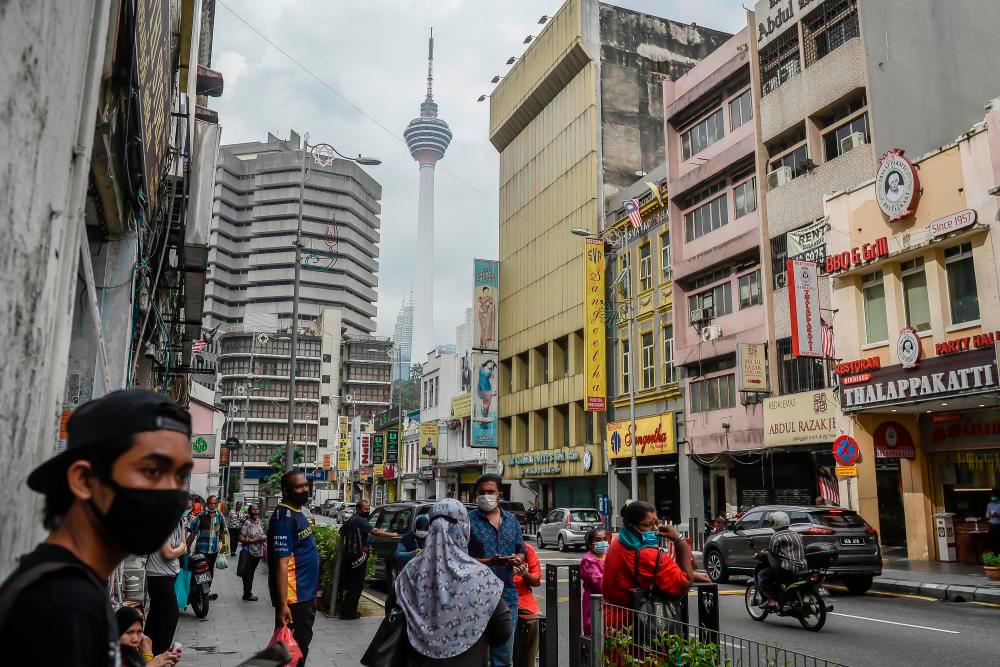THE decision by the Monetary Policy Committee (MPC), the independent sub-institution within the autonomous Bank Negara Malaysia, to raise the overnight policy rate (OPR) by 25 basis points to 2.75% on Nov 3, can only eat into the disposable income of the majority of Malaysians – perhaps what would be now the B70. It comes at a time when the rakyat is still feeling the pinch.
The Statistics Department recorded that Malaysia’s inflation rate reached 4.5% in September.
So far, the highest was 4.7% from the preceding month, i.e, August.
In turn, this marked an increase from 4.4% in July. Then too, the hiked-up prices remained “sticky”.
Hence, even when the inflationary pressure has eased there’s no corresponding decline, which should, ideally, be the case.
This could be attributed to the rent-setting power of landlords who, more often than not, refuse to lower rental prices to protect their new margins, for example. Corruption as a way of life is another salient reason.
The inflation rate typically comes down (as in disinflation) due to either the decline in costs (the opposite of “cost-push”) or demand (the opposite of “demand-pull”).
The principal cause of inflation in Western economies today (as was the case last time in the 1970s) has been energy-driven or related – oil in the case of the US or gas in the case of Europe (including the UK).
Recently, the S&P reported that the highest earnings sector in the US is still oil and gas.
As mentioned by Reuters, energy is the only sector of 11 S&P 500 sectors in positive territory so far for 2022.
The stock market rally definitively reflects the earnings which have jumped by 120% compared with last year.
Energy and energy-related bills such as utilities and food (passed on by transport and logistical costs) continue to be the top drivers of inflation in the US for 2022, moving forward.
At the micro-level, “gasoline and power bills now account for about 34% of the monthly budgets for the lowest-earning consumers, up from 31% last year”.
The Wall Street Journal has highlighted how energy inflation is not only the highest but also the most persistent.
On the other hand, to be fair, the Federal Reserve Bank of Chicago has pointed out that durable goods prices have played an outsized role in overall inflation (i.e, compared with Europe).
This “puzzle” can be partly explained by reference to what is known as the “bullwhip” effect.
What it means is that a small shift (i.e, increase) in demand in the downstream (i.e, retail) sector – concerning consumers – can amplify or cause a ripple effect of a large shift in supply and production in the midstream and, by backward extension, the upstream (i.e, demand for raw and semi-processed materials) within the supply chain ecosystem.
It can transfer higher prices from one sector (sub-sector) – for durable goods – to another (as in the case of semiconductors/microchips, where there had been a surge in book orders by the electronics manufacturing sector to safeguard against logistical disruptions) and may cause fluctuations (as excess inventory leads to markdowns before reversion).
In short, the overall durable goods sector will still show inflationary pressure nonetheless, analogous to the shuffling of reserve balances among banks in the interbank market (i.e, these are not “leaked out” to be loaned to retail customers, which is why quantitative easing or QE was never inflationary to begin with, among other things).
And in looking at the main components or contributors to inflation in the EU, energy remains at the highest rate.
According to Eurostat for October, energy’s contribution to inflation was 41.9%.
This was followed by food, alcohol and tobacco from a distance at 13.1%.
In short, profit gouging – cartels taking advantage of geopolitical tensions to drastically mark up prices whether directly (price-setting power even as oil companies prefer to sweat out pre-existing investments in oil rigs and also to “compensate” for lower earnings under the Donald Trump years in the US) or indirectly (i.e, through the futures markets transmitting to the wholesale markets in Europe).
All this comes back to the classic mainstream economic concept of the Phillips Curve based on the wage-cost spiral so that demand for higher wages leads to higher business costs that are then passed back to the consumers.
In short, the Phillips Curve describes a cost-push situation.
Inflation is a complex phenomenon. As the Stagflation of the 1970s, which was caused by the oil or energy crisis emanating from deliberate cuts in production by the Organisation of Arab Petroleum Exporting Countries cartel shows in response to the Fourth Arab-Israeli War, the origins of inflation are normally unrelated to demand-side dynamics.
In turn, the Phillips Curve forms the basis for identifying (or determining) the Nairu (non-accelerating inflation rate of unemployment) in which it is posited that there’s a point where the trade-off between (low/high) inflation and (high/low) employment reached its limit in the long term.
This is when the wage-cost spiral will have a chain effect, irrespective of the level of unemployment.
Critically, it is also an implicit admission of the constraints of monetary policy in bringing inflation down (which could only hope, at best, to aim for price stability in the long run, i.e, rather than focusing on levels of employment).
The Nairu, therefore, coincides with the stable natural rate of unemployment (i.e, the equilibrium or steady state between inflation and employment levels).
Inflation only came down at a very high cost. Examples are the two Volcker recessions in the US, i.e, in 1980 (10.8% unemployment) and 1981 to 1982 (11% unemployment).
The ultimate aim (the sub-text) of monetary policy, therefore, which has been touted as success stories, is to inject deflationary pressures into the economy to push down prices.
In the case of the UK, it is now supported by fiscal policy levers in the form of across-the-board tax rises plus spending cuts (austerity) which we are witnessing under the Rishi Sunak- Jeremy Hunt duo (for an economy that’s now languishing, as it is, under the weight of high energy and energy-related prices).
The pretext is, of course, to plug the £50 billion (RM270 billion) fiscal hole.
Ironically, for a ruling government that prides itself in the sophistication of the free-market tradition, this is a very crude form of tackling inflation compared with the ordoliberal (social market economy) consensus in Germany.
In the final analysis, monetary policy can be deployed on the pretext that the problem is “demand-pull” when it is “cost-push” in the first place.
This means that monetary policy can be an overkill used in an excessive sense.
Whenever macroeconomic policies target inflation primarily by way of interest-rate setting, it inevitably means loss of income and, therefore, weaker purchasing power for those on the lower rung of the socio-economic ladder (as can be seen from Reaganomics and Thatcherism).
The rich and the top percentile of society benefit from an even stronger purchasing power from the lower costs and prices as well as a stronger currency.
This is why using monetary policy to discipline inflation, or in the case of the MPC to achieve some degree of normalisation (consistent with price stability), is ineffective at the macro-level.
It increases government, private sector and household borrowing costs set against the (current) context of a cost-push phenomenon, which is easing and expected to ease.
Shipping costs have come down by at least 60% from their peak (in the September to November 2021 period), as per Statista 2022.
The net effect is that monetary policy would now be, unwittingly, taking over the role as the primary driver of inflation.
At the end of the day, as long been advocated by EMIR Research, fiscal policy via taxation is the best tool to discipline inflation.
Interest rates are a form of long-term contractual “consumption tax”, whereas corporate and personal taxes are income-driven.
Taxation regulates demand (and also supply) in the economy on a targeted and precision-guided basis.
It can either take the form of tax rises or tax cuts or even both together for the same target group to offset one measure against the other.
All this while simultaneously providing the government with the revenue to stimulate the economy when the deflationary impulse approaches recession (without causing inflationary pressures in turn).
A survey conducted by Ilham Center, O2 Research and Huayan that was published in five media outlets under the heading “What the Rakyat Want”, shows that the majority of Malaysians are concerned about the state of the economy (as argued for a long time by EMIR Research, namely the tummy or perut economy).
For the poor people at the bottom of the socioeconomic and economic pyramid, the higher cost of living will push them deeper into poverty.
This means increased government spending on cash transfers and subsidies, even if there is going to be some form of rationalisation eventually since the targeted recipients can only increase.
The previous and now caretaker government has admitted that there will be changes in the social classifications where the T20 and M40 will decrease and the B40 is expected to become the B60.
On the contrary, not only deflation but inflation also (i.e, either way) further enriches the rich.
For example, higher OPR results in higher interest rates which pushes up the bank’s overall earnings and, by extension, share prices and, therefore, the dividends.
Shouldn’t the cumulative OPR hikes, therefore, be offset by wealth tax and capital gains tax? And should a multi-tiered and special GST ever be reintroduced? How about a windfall tax on banks?
The government has a political and moral duty to reduce the impact of inflation on the rakyat and, thus, ought to do more.
Farah Natasya is a research assistant at EMIR Research, an independent think tank focused on strategic policy recommendations based on rigorous research. Comment: letters@thesundaily.com















